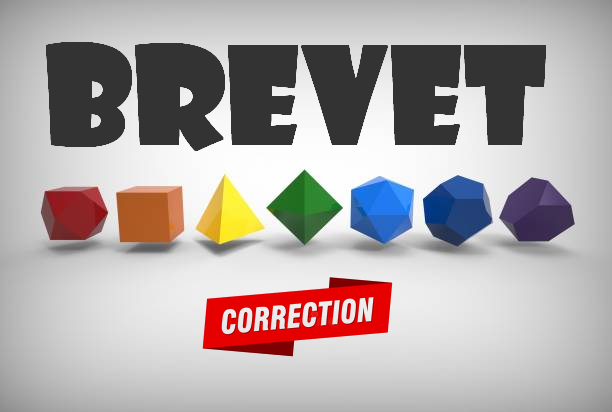Le corrigé du sujet du brevet de mathématiques de juin 2016.
Exercice 1 :
- 2.
- Usine A :
%
Usine B : %
Uniquement l’usine A possède un contrôle satisfaisant?
Exercice 2 :
- Programme A :
- Programme B :
- Programme A = programme B
Exercice 3 :
Figure 1 : ABC est un triangle rectangle et .
Figure 2 : ABC est un triangle rectangle et
donc
Figure 3 :
Exercice 4 :
€
- a.
b.
3.
€
Exercice 5 :
Il faudra 2 sacs soit €
Propriété : (AS) // (RC) car deux droites perpendiculaires à une même troisième sont parallèles entre elles.
2. On sait que
d’après la partie directe du théorème de Thalès, nous avons :
donc
Exercice 6 :
Partie 1 :
- Morceau 1 = 8 cm et morceau 2 = 12 cm.Un carré de côté 8:4=2cm et un triangle équilatéral de côté 12 : 3 = 4 cm.
-
avec AH la hauteur du triangle équilatéral.
Nous obtenons .
Partie 2 :
- Soit x : la longueur du morceau 1.
2. a.
b.
Exercice 7 :
Oui, il peut ajouter un litre d’eau colorée sans risquer le débordement.
Retrouvez chaque semaine de nouveaux cours de maths adaptés à votre niveau!
Continuez à vous exercer en consultant les exercices de mathématiques 3 ème .
Vous pouvez également retrouver de nombreuses vidéos de maths sur notre chaine Youtube!
Les mathématiques avec nous c’est facile, alors comptez sur nous !
Télécharger et imprimer ce document en PDF gratuitement :
Vous avez la possibilité de télécharger puis d'imprimer gratuitement ce document «corrigé du brevet de maths France 2016» au format PDF.
D'autres cours et exercices à consulter
- Corrigé du brevet de maths France 2017
- Corrigés du brevet de maths et DNB des collèges
- Corrigé du brevet de maths 2021 en France
- Corrigé du brevet blanc de maths 2020


